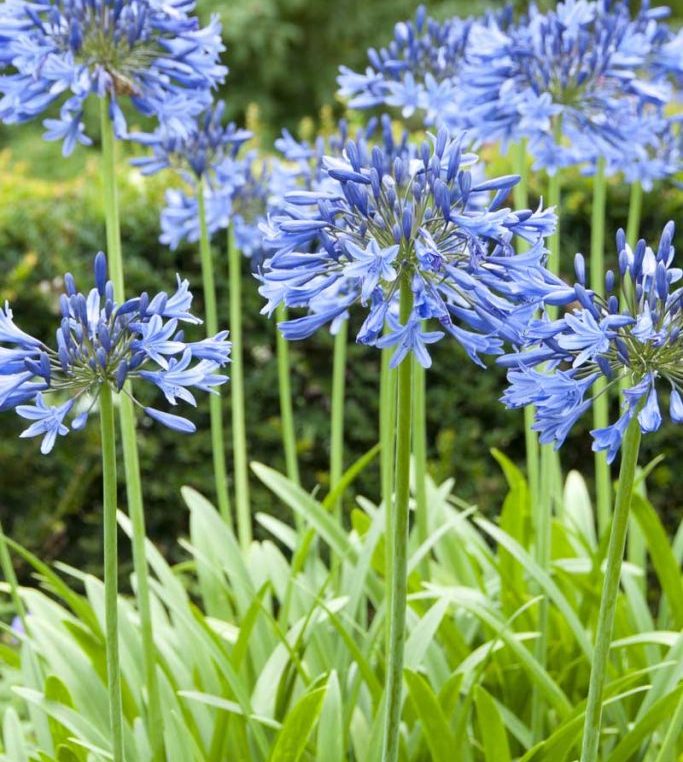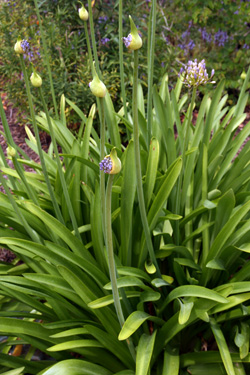
Agapanthus, also called “Lily of the Nile” and “African Lily,” is a perennial herb that blooms in the summer and has huge blue flowers.
Lack of sunlight, soggy soil, frost-damaged flower buds, an excess of nitrogen, recent planting, potting, or division, as well as transplant shock, are the causes of agapanthus not blossoming.
Agapanthus needs full light, soil that drains well, protection throughout the winter, and time to establish itself after planting before it can produce flowers.
Learn why your agapanthus isn’t blooming and how to make sure it does the following summer by reading on.
Table of Contents
Agapanthus Not Flowering after Planting, Potting or Dividing
As a result of transplant shock and possible root damage when dividing, agapanthus frequently produces less flowers in the first year following planting, repotting, or division of crowded roots.
As agapanthus are typically grown in a temperature-controlled greenhouse with ideal conditions before you purchase the plant, it can take the plant some time to adapt to its new surroundings since most gardeners cultivate their agapanthus outside of the ideal South African climate and conditions.
As a result, the agapanthus may not be able to flower as a result of the shock of going from a greenhouse with controlled conditions to your yard.
The majority of a plant’s energy is focused on growing its beautiful green foliage and establishing its roots in the soil during the first year after planting rather than producing blooms.
Also keep in mind that repotting is best done in the spring before the plants begin to grow, though the plant can still be successfully divided in the fall.
Dividing or repotting agapanthus in the spring allows it to establish itself while the earth is warming up, before it must deal with high Summer temperatures that may make it more susceptible to drought and thus create unfavorable conditions for flower buds to grow.
If the agapanthus is in full sun and well-draining soil, it should abundantly display flowers the next year. Water the agapanthus well in its first year and feed it with some potash fertilizer after August to assist grow the flower buds for the following year.
For a visual explanation of the ideal methods for re-potting and dividing agapanthus, view this YouTube video:
Protect the Flower Buds in Winter
The agapanthus’ flower buds form in the fall, and the plant blooms the following year.
The flowers’ buds are vulnerable to frost damage in cold climates, which prevents the agapanthus form from blooming the following Spring.
The fix: Plant agapanthus in pots and relocate them to a protected, frost-free area to minimize frost damage to the flower buds (such as a green house).
As an alternative, you can use fleece, which is sold on Amazon or at garden centers, to protect the plant from the cold and insulate the flower buds.
It is still important to protect the agapanthus flower buds with fleece or with a mulch made of straw during the winter if you are planting agapanthus in garden borders since deciduous varieties are less susceptible to the cold.
The flower buds on your agapanthus might exhibit their flowers in the spring because of insulation from the cold.
Use a High Potash Fertilizer to Encourage more Agapanthus Flowers
Agapanthus may produce more foliage than blooms if fertilizer is applied too liberally.
Use a balanced 10:10:10 NPK all-purpose fertilizer at the start of spring instead of any high nitrogen fertilizers (which produce agapanthus with lots of green leaves but no blooms) (also follow the manufactures instructions).
If the planting area has been amended with organic material beforehand, fertilizer use is typically more crucial for agapanthus in pots and containers as there is less capacity for nutrients than in garden borders.
After deadheading the flowers from this year, the secret to encouraging agapanthus blossoming is to use a feed that is heavy in potash (potassium).
The bud development for agapanthus begins in the late summer or early fall. In order for the flower buds to bloom the following spring, they must be safeguarded over the winter.
Switch to a fertilizer with a greater proportion of potash (available on Amazon or in garden shops) to feed the plant with the right nutrients at the right time. A high potash fertilizer helps to encourage the development of flower buds.
Use a potash feed from August through October after this year’s flowers have gone (always follow the manufacturer’s instructions), since this helps the agapanthus grow additional flower buds that will be exhibited the following Spring.
Agapanthus Prefers Full Sun for Flowering
Agapanthus can withstand drought and flourish in full sun for at least six hours each day.
If your agapanthus is not flowering, it may be because it is planted in too much shade or is being shaded by nearby plants. The amount of sun is directly associated with the display of blooms.
While agapanthus should be relocated (ideally in the spring or fall) and planted in a sunnier garden border, potted plants should be moved to a sunny, warm environment if in the shade.
Agapanthus needs time to establish, so it’s best to avoid digging it up and planting it in the summer. The heat will cause the plant to wilt and lose water before the roots have a chance to set down and draw in water.
Watering and Soil Conditions for Agapanthus Flowering

Consider growing agapanthus as being similar to growing Mediterranean plants like lavender, rosemary, and thyme in terms of soil and watering requirements. Agapanthus has a high tolerance for drought and prefers soil that dries out a little between watering sessions or periods of rainfall.
Avoid growing agapanthus in thick clay soil as they are particularly prone to rot and fungal infections if planted in marshy ground which creates stress and inhibits the plant from flowering.
Agapanthus needs a light, friable soil that has been amended ideally with compost and, if you live in an area with heavy rainfall, perhaps with some sand or grit to help with drainage.
Because of the good drainage, agapanthus grows particularly well in pots and containers.
In most regions, give potted agapanthus a good soak once a week during the Spring and Summer to stimulate the roots to set down and maintain the plant healthy so it may flower, whereas agapanthus planted in garden soil rarely needs any watering after the first year of planting.
Key Takeaways:
- The major reasons agapanthus don’t bloom include inadequate sunlight, excessive fertilizer, injured flower buds from frost, soggy soil, or stress following planting, re-potting, or division.
- Agapanthus blooms in soil that drains well and is protected from frost, and it frequently produces its best blooms a year after planting.
- A fertilizer treatment in August that contains more potash (potassium) can increase the growth of flower buds that will bloom the following year.
- The optimal conditions for agapanthus growth and blooming are full light and good drainage.
FAQ
How long does it take agapanthus to grow?
Roughly 3-5 years
How long does it take for agapanthus to flower?
Agapanthus plants typically take three to four years to mature and bloom after being started from seed.
Does agapanthus bloom the first year?
Usually, agapanthus doesn’t bloom its first year. Conditions for growth If your agapanthus doesn’t blossom, it can be yearning for sunlight, as agapanthus needs at least six hours of sunlight each day. The plant might benefit from shade during the height of the day in a particularly hot area, but that is the lone exception.
